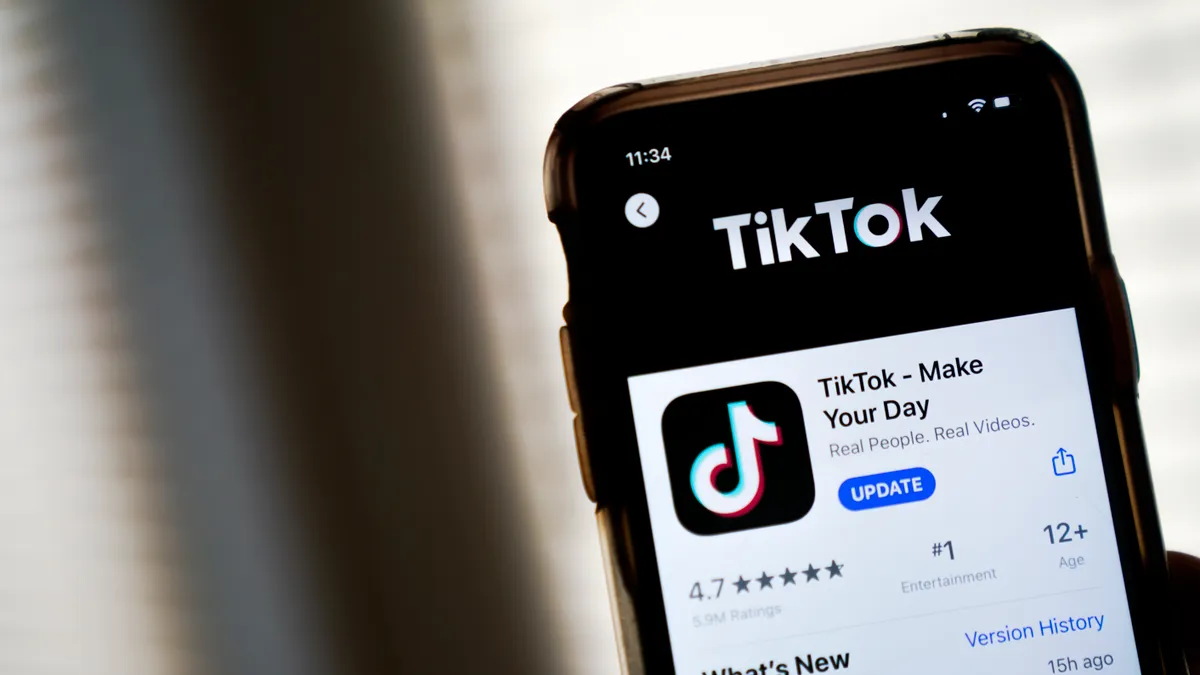Despite a growing number of limited bans — and the possibility of a national one — amid security concerns and privacy issues, TikTok remains the dominant app for consumers between the ages of 16 and 25. However, if the app were to go away in the U.S., the fallout won't be as simple as traffic migrating to one particular competitor, according to a report by Measure Protocol.
The “App Life Report” found that TikTok has evolved beyond a video sharing app to a shopping and searching app as well. TikTok is responsible for 1% of all paid iOS in-app transactions. Additionally, 74% of TikTok users now use it as a search destination, with 28% conducting more than a hundred searches a month.
“[TikTok] was a competitor to Facebook, Instagram and YouTube, but increasingly it's becoming a search destination. The content is changing and so are the users' behaviors,” said Paul Neto, co-founder and CMO of Measure Protocol in emailed remarks.
TikTok’s many uses
In January of 2023, people between the ages of 16 and 25 spent an average of 12.7 hours a week on TikTok, with 78% of consumers in the age group reporting have used it. The app that drew in the second highest total time was chat app Kik Live at 9.8 hours. However, it was only used by 3% of this cohort. YouTube, while the most popular app with a usage rate of 92%, only saw an average use time of 6.6 hours, according to the report.
The data supporting YouTube’s popularity and high usage rate suggests the platform would be the most logical choice for TikTok migration if the app was to go away in the future. However, the reality is likely more complicated than that. TikTok is used by many as a shopping destination in a way YouTube is not. The average in-app spend per user on TikTok is $9.83, a rate second only to popular game developer Gram Games at $31.45. This high spend per user makes the app ideal for marketers looking to sell directly to consumers.
As a search engine, the two most popular search terms on TikTok for consumers between the ages of 16 and 25 is “how to” and “what is.” The report found that such terms are more popular than major celebrities such as Harry Styles and Taylor Swift, showing consumers are increasingly turning to the platform for informative content. This could potentially mean as consumers spend more time on TikTok conducting research, they are less likely to use other services, according to Neto.
“Individuals' time on an app or service is a balance and compromise at the expense of another activity, service or platform. For every hour spent on TikTok, that's an hour not spent elsewhere,” said Neto.
Competitors are looking for ways to lure users back to their services, which is why TikTok lookalikes have been on the rise, with Meta platforms Instagram and Facebook both implementing a short-form video feature. YouTube also has a short-form feature, and with its popularity, could be a logical choice for many creators who call TikTok home.
When looking more broadly at all consumers over the age of 16, 91% use YouTube, spending an average of 5.3 hours a week on the platform. In comparison, only 68% of consumers over 16 are on TikTok. Instagram and Facebook are a little more popular, with 81% and 72%, respectively, but a lot less time is spent on those apps. Only 3.4 hours a week are spent on Instagram on average, and 3.8 hours on Facebook.
“The fragmentation of media and app usage has made it difficult to fully understand the true behaviors of individuals. This complication is layered with the changing regulatory landscape… big players like Google and Apple cracking down on data access… and consumers themselves becoming more concerned surrounding the use of their data,” said Neto.
Life after TikTok
While the scope of a national TikTok ban remains unclear, so does where most of the traffic would go is such a ban were to happen. With so many lookalikes, the audience could fracture and end up on a number of different platforms. Women are TikTok’s most active users, browsing an average of 6,819 videos in January of 2023. Men, on the other hand, browsed 5,666 videos. Women also tend to be more active on the site in general, with 34% posting a video during that month compared to 27% of men. Eighty-six percent of women also liked a video, compared to 79% of men.
With such differences in behavior, one possible impact of a broad ban would be a splintering of the user base. However, along what lines users will fracture and where they will migrate to has yet to be determined. While cross channel distribution of TikTok’s content is already rampant, how creators might react to the loss of their home base remains unclear.
“The real question becomes if there is a ban, how broad will it be and how will TikTok respond to it? A ban of any sort will certainly lead to creativity for not only other platforms, but also for creators,” said Neto. “We will be carefully watching our data over the coming months to see if there are any shifts in consumer behaviors.”






















